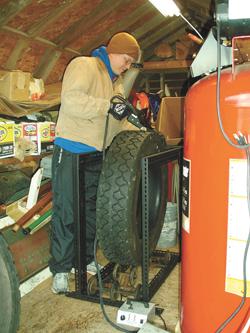
Before you toss any used truck tires, check to see if they're labeled "regroovable." A standard regroovable tire can run for another 25,000 to 30,000 miles, says Rob Cornell.
Cornell started regrooving tires when he was an owner/operator of a Fedex delivery truck. Tires on the truck cost him about $200 each, but regrooving the four rear tires cost him practically nothing. The upfront cost of a regroover was relatively inexpensive.
"I bought a Van Alstine G100 with extras," says Cornell. "It plugs into household current, and if I am really deep or the blade is dull, I can crank up the heat and it will go. I can often go through half a dozen tires with a single blade."
With blades relatively cheap, tire regrooving really paid for Cornell.
To make the job easier, Cornell designed and built a tire regrooving cage. He saw a used one for sale on eBay, but his cost him nothing.
Cornell wanted to be able to spin the tires as he regrooved. At the same time the cage needed to be able to hold the tire in place if the going was difficult. His regrooving cage does both. The cage is four sided with an open end and top. Cornell rolls the tire in the end and rotates it on roller assemblies. When he needs the tire stabilized, he can lean it against either side or move it forward so it's wedged between a roller assembly and the end of the cage.
Roller assemblies came out of a junked snowmobile. Each assembly consists of a set of three rollers in line followed by a set of two. The tire rolls forward over the first assembly and then rides between it and a second assembly, rotating on the two pairs of rollers.
Cornell built the 18 1/2-in. wide by 36 1/2-in. long by 38-in. high cage out of discarded shelving framework. The 1 1/2-in. by 3 1/2-in. angle iron was thick enough to be strong, yet easy to bore out and bolt together. Base pieces extend a few inches beyond the width of the cage to provide added stability.
To mount the assemblies, Cornell cut two additional 26-in. strips of the angle iron. He mounted them with the 3 1/2-in. side perpendicular to the floor, allowing him to bolt the assemblies through the high sides. They ride just above the floor so the rollers can spin freely. A clothesline hook over the center of each roller assembly axle and bolted to the framework helps keep them from twisting under the weight of a tire.
To regroove a tire, Cornell first checks it with a tread depth gauge. When he's finished, he has to have at least 3/32 in. of material from the bottom of the groove to the top. On a snow tire, he might have 10/32 to 12/32 in. remaining when finished.
"Tires are incredibly thick if they are made to be regrooved," says Cornell. "If you get too deep, you can see the core of the tires with the metal belting. You don't want to go that deep."
Cornell says regrooving is easy to do. Simply insert the regroover into the existing grooves and retrace them. The regroover uses a combination of heat and a cutting blade to remove material.
"You want to go over the tire first to remove any stones or glass buried in the tread as they will dull the blade," he says. "If there are exit channels, they need to be regrooved as well. Just follow the old pattern of grooves."
Cornell regrooves tires for some of his former co-workers and others. He says it makes a nice sideline for him, but allows that anyone could do it for themselves for only a few dollars per tire.
"When I started regrooving my tires, none of the guys I worked with knew it could be done," he says. "As long as you follow Department of Transportation guidelines, you can do it. It's not rocket science."
